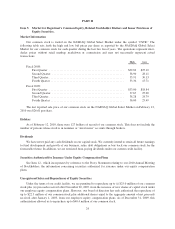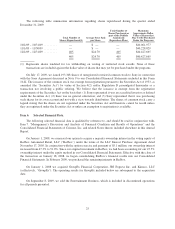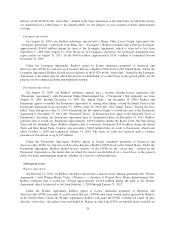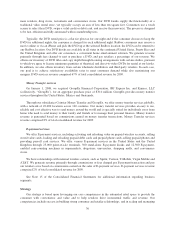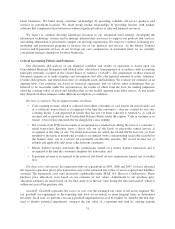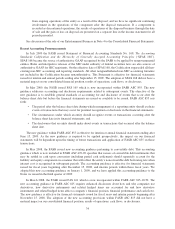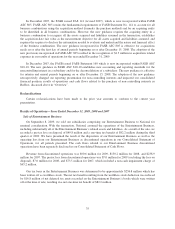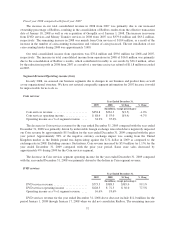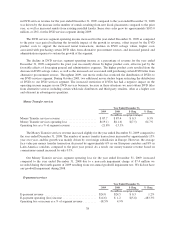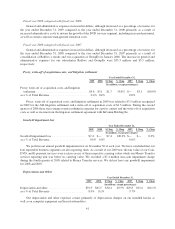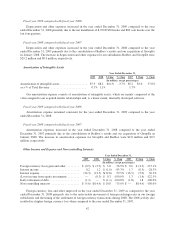Redbox 2009 Annual Report Download - page 40
Download and view the complete annual report
Please find page 40 of the 2009 Redbox annual report below. You can navigate through the pages in the report by either clicking on the pages listed below, or by using the keyword search tool below to find specific information within the annual report.from ongoing operations of the entity as a result of the disposal; and we have no significant continuing
involvement in the operations of the component after the disposal transaction. If a component is
recorded as discontinued operations, the results of operations of the disposed business through the date
of sale and the gain or loss on disposal are presented on a separate line in the income statement for all
periods presented.
See discussion of the sale of our Entertainment Business in Note 4 to the Consolidated Financial Statements.
Recent Accounting Pronouncements
In July 2009 the FASB issued Statement of Financial Accounting Standards No. 168, The Accounting
Standards Codification and the Hierarchy of Generally Accepted Accounting Principles (“SFAS 168”).
SFAS 168 became the source of authoritative GAAP recognized by the FASB to be applied by nongovernmental
entities. Rules and interpretive releases of the SEC under authority of federal securities laws are also sources of
authoritative GAAP for SEC registrants. On the effective date of SFAS 168, the Codification superseded all then-
existing non-SEC accounting and reporting standards. All other nongrandfathered non-SEC accounting literature
not included in the Codification became nonauthoritative. This Statement is effective for financial statements
issued for interim and annual periods ending after September 15, 2009. The adoption of SFAS 168 did not have a
material impact on our consolidated financial position, results of operations, cash flows, or disclosures.
In May 2009, the FASB issued FAS 165 which is now incorporated within FASB ASC 855. The new
guidance addresses accounting and disclosure requirements related to subsequent events. The objective of the
new guidance is to establish general standards of accounting for and disclosure of events that occur after the
balance sheet date but before the financial statements are issued or available to be issued. FASB ASC 855 sets
forth:
• The period after the balance sheet date during which management of a reporting entity should evaluate
events or transactions that may occur for potential recognition or disclosure in the financial statements;
• The circumstances under which an entity should recognize events or transactions occurring after the
balance sheet date in its financial statements; and
• The disclosures that an entity should make about events or transactions that occurred after the balance
sheet date.
The new guidance within FASB ASC 855 is effective for interim or annual financial statements ending after
June 15, 2009. As the new guidance is required to be applied prospectively, the impact on our financial
statements will be dependent upon the timing of future transactions and application of FASB ASC 855 on those
transactions.
In May 2008, the FASB issued new accounting guidance pertaining to convertible debt. This accounting
guidance which is now included in FASB ASC 470-20 specifies that issuers of convertible debt instruments that
may be settled in cash upon conversion (including partial cash settlement) should separately account for the
liability and equity components in a manner that will reflect the entity’s nonconvertible debt borrowing rate when
interest cost is recognized in subsequent periods. The accounting guidance is effective for financial statements
issued for fiscal years beginning after December 15, 2008, and interim periods within those fiscal years. We
adopted this new accounting guidance on January 1, 2009, and we have applied this accounting guidance to the
Notes we issued in the third quarter of 2009.
In March 2008, the FASB issued FAS 161 which is now incorporated within FASB ASC 815-10-50. The
new accounting guidance in FASB ASC 815 requires enhanced disclosures about how and why companies use
derivatives, how derivative instruments and related hedged items are accounted for and how derivative
instruments and related hedged items affect a company’s financial position, financial performance and cash flows.
The new guidance is effective for financial statements issued for fiscal years and interim periods beginning after
November 15, 2008. The adoption of the new accounting provisions within FASB ASC 815 did not have a
material impact on our consolidated financial position, results of operations, cash flows, or disclosures.
34


